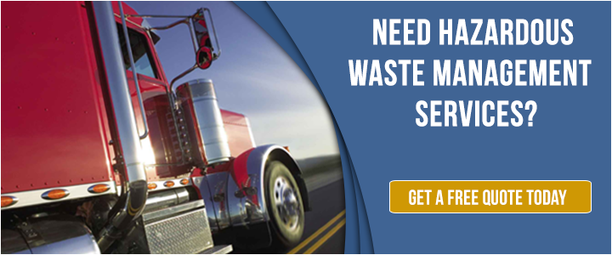Manufacturers and other industries generate a variety of different wastes in the form of solid, liquid, gas, and a combination of the three. Generally, a waste consists of any product that is no longer needed or that can no longer be used for its intended purpose. Based on its effects, waste from businesses may be classified as either hazardous or non-hazardous.
Hazardous waste describes a waste that has the characteristics that make it potentially harmful or dangerous to the human health or the environment. In the United States, 70 percent of hazardous waste is generated by the chemical and petroleum industries. However, the spectrum of hazardous waste production is large and diverse. Both large and small generators produce solids, liquid, gas, sludge, and other byproducts through manufacturing processes, disposal of unused materials or getting rid of unused commercial products.
Under the authority of the Resource Conservation and Recovery Act (RCRA). EPA's regulations establish two ways to determine the definition of a hazardous waste. Hazardous waste can be found on four hazardous wastes lists— F - list, K - list, P - list, or U - list or determined by applying the four characteristics of hazardous wastes.
The Hazardous Waste Listings
Each of the hazardous waste listings contain anywhere from 30 to hundreds of waste streams. The waste on the lists has an assigned waste code, which consists of the letter associated with the listing and followed by three numbers.
F Listed Hazardous Wastes — These waste products are known as “non-specific source wastes”, and consist of particular solid wastes from identified manufacturing and industrial processes. Rather than reference to specific industries, the F listing contains seven groups of hazardous waste as a result of processes:
- Spent solvent wastes (F001 - F005)
- Electroplating and other metal finishing wastes (F006 - F012, and F019)
- Dioxin-containing wastes (F020 - F023 and F026 - F028)
- Chlorinated aliphatic hydrocarbons production wastes (F024 and F025)
- Wood preserving wastes (F032, F034, and F035)
- Petroleum refinery wastewater treatment sludge, (F037 and F038)
- Multi-source leachate (F039)
You can find further information about the F listing in 40 CFR §261.31(a).
K Listed Hazardous Wastes — This group of hazardous wastes consist of “source -specific wastes” or waste from certain specific industries. This classification contains the following 13 subgroups:
Wood preservation (K001)
- Inorganic pigment manufacturing (K002 - K008)
- Organic chemicals manufacturing (K009 - K011, K013 - K030, K083, K085,
- K093 - K096, K103 - K105, K107 - K118, K136, K149 - K151, K156 - K159, K161, K174 - K175, and K181)
- Inorganic chemicals manufacturing (K071, K073, K106, and K176 - K178)
- Pesticides manufacturing (K031 - K043, K097 - K099, K123 - K126, and K131 - K132)
- Explosives manufacturing (K044 - K047)
- Petroleum refining (K048 - K052, and K169 - K172)
- Iron and steel production (K061 and K062)
- Primary aluminum production (K088)
- Secondary lead processing (K069 and K100)
- Veterinary pharmaceuticals manufacturing (K084 and K101 - K102)
- Ink formulation (K086)
- Coking (K060, K141 - K145, and K147 - K148)
P and U Listed Hazardous Wastes — Both of these hazardous waste listing deal with certain commercial chemical products or CCPs that are discarded or intended to be discarded. The P and U listed categories contain generic names of chemicals, off-specification products, chemical spills and container residues. The primary difference between the two lists is that the P list identifies acute hazardous wastes and the U list identifies toxic wastes.
Characteristics of Hazardous Wastes
Some waste streams may not be contained within the four lists. However, your business has the responsibility to determine if waste streams generated from their operation exhibits any of the four characteristics of hazardous waste, which are:
- Ignitable — This type of waste, which includes waste oils and used solvents, can lead to fires under certain conditions, create spontaneous combustion, or has a flash point at certain temperature.
- Corrosivity — Corrosive wastes consist of materials such as solids comprised of acids or bases, or generates alkaline or acidic solutions, or liquid waste that may corrode metal containers.
- Reactivity — This property refers to wastes that are “reactive or unstable under normal conditions, which could cause explosion or release toxic fumes, gases, or vapors under certain conditions.
- Toxicity — Toxic wastes refer to wastes that are harmful or fatal when absorbed or ingested . Examples are wastes that contain DDT, PCBs, mercury, and lead.
To make a hazardous waste determination involves a complex task that is a critical part of the hazardous waste rules. If you do determine that your waste is hazardous, you will want to contact a hazardous waste disposal company to make sure that all of your waste is being disposed of in order to avoid hefty fines.
Whether you are a large generator or a small generator, the management of your waste stream must comply with regulations, which are strictly enforced by the Environmental Protection Agency (EPA) and the appropriate state agency.


Comment